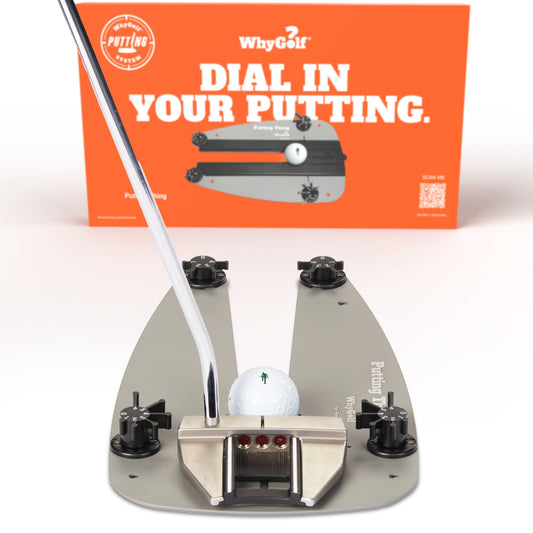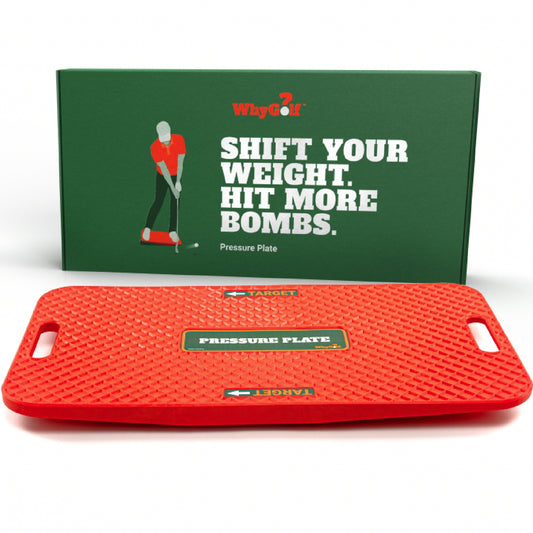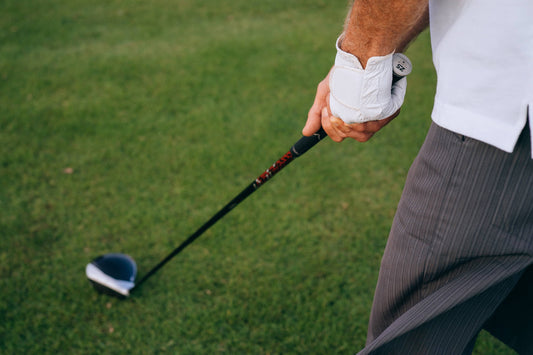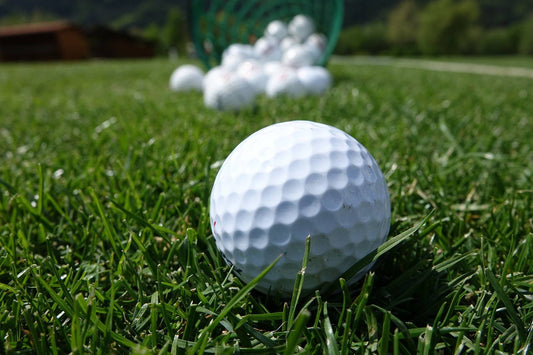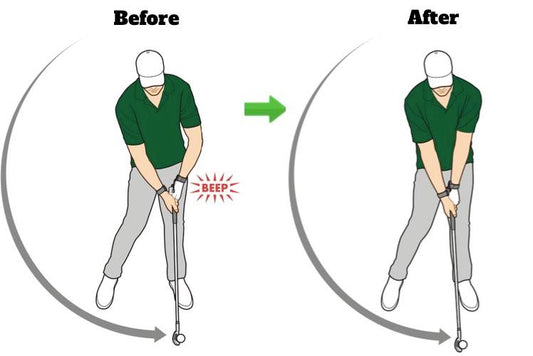Author: WhyGolf WhysGuy
We want to preface this guide with the acknowledgment that neither WhysGuy nor anyone from the WhyGolf team claims to know everything about the golf swing. We don’t want anyone to treat what we say here as gospel. While much of what we’ll say is a reflection of decades of dialogue with PGA instructors and players, we’re always learning and we understand that knowledge about the sport of golf will continue to evolve over time.
In this post, WhysGuy will cover:
- What is smash factor and why do people care about it.
- Why smash factor is generally only important to optimize when hitting driver.
- Practical tips to help you optimize your smash factor with your driver.
What is Smash Factor?
Smash factor is a term that is frequently used in today's game and therefore it's worth defining.
Here’s how Ping described smash factor in a blog post:
“Smash Factor is calculated by dividing the ball speed by clubhead speed. For example, if you swing a driver with a clubhead speed of 100 mph and generate a ball speed of 150 mph, the Smash Factor is 1.50. So, the higher the Smash Factor, the more ball speed you are getting for a given clubhead speed."
Put simply, smash factor in golf explains how fast your ball speed is in relation to your clubhead speed. With the driver, the higher the ratio - the better. With irons, it's not that simple.
Let's dive deeper.
Does Smash Factor in Golf Matter?
With the driver, it makes logical sense to optimize your smash factor. More ball speed = shorter shots into the greens. Shorter shots = closer approaches, resulting in more birdies. Fairly straight-forward.
With irons, however, smash factor isn't nearly as important to optimize. Why?
While a high smash factor can aid in the production of longer shots, great iron play cannot exist without accuracy and precision. With the irons, it's more important to make sure your getting enough spin and launching the ball high enough so as to ensure that you can hold greens consistently. If you choose to optimize for smash factor with the irons (i.e., opt for irons that "spring" off the face), it's important to realize that your accuracy and precision may suffer as a result.
Therefore, the rest of this article will offer advice on how to increase your smash factor in golf with the driver.
1. Smash the Center of The Clubface
When hitting drivers, your smash factor can fluctuate from 1.2 to 1.5 from one shot to the next. How?
Most of the variation can be explained by the quality of your contact with the golf ball (i.e., heel or center strike). Hitting the ball from the so-called "sweet spot" does, in fact, result in a sweet result: higher ball speed and more distance.
The first step to smashing the center of the clubface is to ensure that you have the ability to detect whether you are hitting it off the center of the face after each golf shot. You may find Golf Impact Tape to be helpful to gather an awareness of where on the clubface you are making contact with the golf ball. This awareness will, over time, guide you on your journey to consistent center-hits.
2. Check Your Ball Position
Many golfers tend to have their ball position too far back in their stance with the driver. This often results in a heel strike. Why?
Your ball position at setup impacts the point at which your clubhead makes contact with the golf ball.
Since your ball position is too far back, you will hit the ball sooner in your swing arc - which often can lead to a heel strike due to an open clubface at impact.
The fix? Make sure your ball position with driver is off your front foot.
If you want to learn about 4 signs that your ball position is incorrect, click here.
3. Stop Swaying
A key strategy to increasing your smash factor is to simply increase your clubhead speed. Doing so will allow you to tap into your driver's "spring" effect, resulting in more ball speed per unit of clubhead speed.
Many golfers inadvertently limit their clubhead speed by swaying instead of exhibiting proper rotation. When you sway, you lose out on a ton of lower body movement and make it nearly impossible to maximize clubhead speed.
To stop swaying and start rotating, the first thing you want to do is flare your feet slightly at address. This makes it easier to rotate around your body and load the weight on your backside so you can unwind on the downswing. Learn more about how to stop swaying here.
You can use the Pressure Plate to learn how to shift your pressure as opposed to weight in your golf swing. The Pressure Plate will teach you how to shift pressure into the ground as opposed to wasting it by sliding laterally in your golf swing, allowing you to increase your clubhead speed and smash factor.
4. Get a Custom-Fit Driver
Another way to optimize your smash factor in golf is to use a driver head and shaft combination that fits your unique golf swing. If you are looking to optimize your smash factor in golf and are using a stock driver off the rack, it may be time to get a custom fit driver. Doing so will allow you to optimize your smash factor and by extension - distance. Every professional golfer spends hours and hours finding the right shaft/head combination for their golf swing so why not approach your game with the same deliberation?
Generally speaking, a lighter shaft will increase your clubhead speed and you may also find that a shaft with a lower kick point may also add some clubhead speed to your game - ask your clubfitter about it.
If a shaft is too heavy, it’s impossible to swing fast enough to max out clubhead speed. Most golfers will benefit from a driver shaft that is about 60 grams while faster swingers can use 65 or 70 grams.
5. Do Speed Training!
What is speed training?
Here’s what Jaacob Bowden, a PGA professional said in a Golf.com article about speed:
“You don’t necessarily have to get big muscles or grow in size. It’s more about strengthening and speeding up the muscles that you use from the top of the backswing down to impact, in the specific way that you’re using them in the golf swing.”
In other words, the key to speed training is to understand that it's about training your muscles to move quickly and explosively. While building muscle mass can help, there's more to it.
Beginner golfers can benefit greatly from using something like SuperSpeed Golf sticks or Rypstick to add more speed in 8–12 weeks. With only a few sessions per week you can see massive gains in distance and ball speed which makes golf a lot easier.
We also wrote an entire article on how to increase your swing speed: Click here to learn more ways to increase swing speed in golf.
Optimize Your Smash Factor In Golf - Key Takeaways:
- Smash factor in golf represents the ratio between ball speed and clubhead speed. A ratio of 1.5 would mean that your ball speed is 1.5X your clubhead speed.
- While smash factor is important to consider when hitting drivers, it's not nearly as important to optimize with the irons.
- To optimize your smash factor with your driver, it's important to hit the sweet spot, use a driver tailored to your golf swing, and speed train.
Ready to start hitting bombs? Purchase your Pressure Plate here.
What is smash factor in golf?
In golf, the smash factor is a word used to describe the efficiency of a golf stroke. At impact, it is the ratio of ball speed to clubhead speed. A smash factor of 1.50 means that the ball speed is 1.5 times that of the clubhead speed. The greater the smash factor, the more energy is transferred from the clubhead to the ball, resulting in longer drives.
Golfers can boost their smash factor by working on their swing technique and optimizing their equipment, such as choosing the appropriate driver and altering the loft and face angle. A golfer with a fast swing speed may benefit from a lower lofted driver, whereas a golfer with a slower swing speed may benefit from a higher lofted driver to optimize launch angle and spin rate.
Launch monitors or other golf technologies that can offer quick feedback on the quality of a golf shot can be used to measure smash factor. Golfers can increase their distance off the tee and overall performance on the course by enhancing their smash factor.
What is a good smash factor in golf?
Golfers' swing speed, the kind of club they are using, and the course's conditions are just a few of the variables that affect how well they smash the ball. In general, a driver is thought to be good if their smash factor is 1.45 or above.
A golfer's smash factor, for instance, would be 1.45 if their swing speed was 100 mph and their ball speed was 145 mph. For many seasoned golfers, this distance represents the most effective way to transfer energy from the clubhead to the ball.
It is crucial to remember that a golfer's smash factor is only one facet of their performance and that accuracy and consistency are also crucial for success on the course. Irons often have larger smash factors than drivers, and different clubs will have varied ideal smash factors.
Overall, even if longer drives may be the result of a higher smash factor, this is not the only aspect to take into account when assessing a golfer's performance.
How do I improve my smash factor in golf?
In golf, increasing your smash factor can result in longer, more precise strokes, which can eventually help you shoot lower scores. You can work on increasing your smash factor in a number of ways, such as:
Enhancing your swing technique can help you make more effective contact with the ball, which will increase your smash factor. You may do this by working with a golf coach to improve your swing technique.
Optimizing your equipment can help you increase your smash factor. Choose the proper driver and change the loft and face angle. A driver with a lower loft may be advantageous for a golfer with a fast swing speed, while a driver with a higher loft may be advantageous for a player with a slower swing pace to maximize launch angle and spin rate.
Launch monitor practice can help you keep track of your smash factor and make any necessary alterations to your swing and equipment.
Overall, technique, equipment, and practice are all necessary to increase your smash factor. You can hit longer, more precise shots and increase your overall performance on the course by focusing on these areas.
Is Smash Factor Important With Irons?
It’s not as big of an issue when it comes to measuring iron performance. Here’s what Trackman said about it, “The higher the loft of the club, the lower the smash factor is expected to be. A PW should have a smash factor near 1.25.”
What is the average smash factor on the Pga tour?
The average is 1.49 for PGA Tour players.
In fact, it’s about as high as it can go as the USGA limits clubs to 1.50 smash factor. Otherwise, if it’s more than 1.50 a club is deemed illegal and not eligible for tournament play.
Check Out Our YouTube Channel For Drills and Tips



